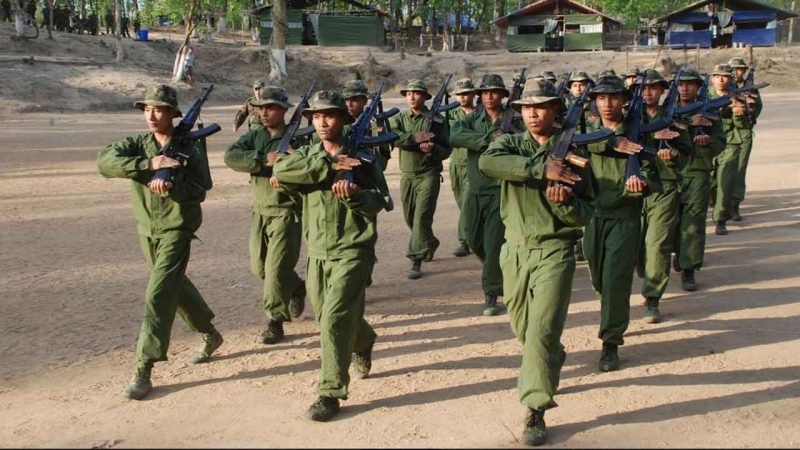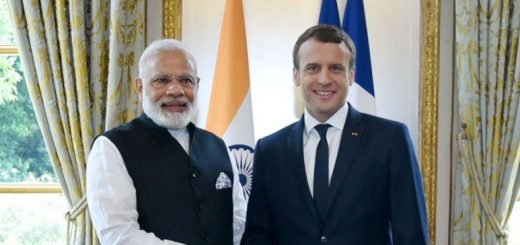An assessment of Insurgent Groups in North East India

Introduction
Modern states like India face many internal and external challenges to their political sovereignty and territorial integrity. The internal security threats that India faces range from security situation in J/K, terrorism in the hinterland, left-wing extremism and insurgency in the North East.
Northeast India faces ethnic conflict, separatist movement, communal violence, illegal migration and insurgency being the most prominent. Now the question one may ask is as to why has there been violent uprising or insurgency in the North East region of India? The answer to this lies in its unique strategic location and distinct demography. India’s North-East region comprises of eight states namely Sikkim, Assam, Arunachal Pradesh, Assam, Meghalaya, Manipur, Mizoram, Nagaland and Tripura. It is strategically placed along with Bangladesh, Myanmar, China, Nepal and Bhutan. North East’s border is majorly International Border where a narrow stretch of land i.e. the Siliguri corridor (Chicken Neck) connects it to the mainland India. Also, the region comprises of more than 200 ethnic tribes which have different dialects, distinct languages, and unique socio-cultural identities. The insurgency is mostly the result of the unfinished process of post-colonial state-making and the unmet aspirations of self-governance and respect of the distinct identity of the people of the northeast region. Insurgency in the northeast can be broadly divided into three types
- Insurgents who demand independence and hence a separatist insurgency.
- Insurgents who want autonomy in order to assert the sub-regional aspirations.
- intra-ethnic conflicts among smaller and dominant tribal groups.

Status of insurgent groups in North East India
On 13th October 2020, a statement was issued by National Socialist Council of Nagaland (NSCN-IM) saying that “the road to a final deal has become ticklish as the sensitive issue of Naga flag and Naga Constitution remains as the sticking point, we have stood our ground on these two non-negotiable issues and we shall continue to stand till the last man standing.” This may be the breaking point of peace talks between the most prominent insurgent group in Nagaland and Government of India. It was originally Nagaland from where insurgency began in North East India. The inner line permit that the British introduced in 1873 in Nagaland kept it isolated and insulated from the rest of India. Post Independence, the Naga community detested the autonomous status given under the Indian constitution and therefore demanded independence under the leadership of A.Z. Phizo of Naga National Council (NNC). The Naga’s were brutally suppressed by the Indian state which resulted in protracted violence and conflict in the region. Later in 1975 Shillong Peace Accord was signed but was unsuccessful. In 1980 the National Socialist Council of Nagaland which demanded “Greater Nagalim” comprising the area of Arunachal, Manipur, Assam, Nagaland and Neighboring Myanmar. The internal rivalry within the group led to the split resultant being the NSCN- Isak Muivah faction and NSCN Khaplang. Throughout the ’80s and early ’90s, Nagaland witnessed violence. In 1997 a ceasefire was reached between NSCN- IM and the government but NSCN-K kept the conflict burning. In 2015 GOI entered in a framework agreement with NSCN- IM. Recently, we have witnessed the break-in talks between NSCN- IM and the Government.
In Assam insurgency began in 1979 with the anti-alien movement of All Assam Students’ Union against the illegal migration from Bangladesh and a shadow group called United Liberation Front of Assam also began its activities. In 1985 the Assam accord was signed ending the anti-alien movement but it was in the 1980s when insurgency activities were accentuated by ULFA. It was later banned by the Government of India in 1990. Along the years, many groups like National Democratic Front of Bodoland (NDFB) and its splinter groups like NDFB-S, Karbi Anglong tribal groups like Karbi Longri North Cachar Hills Liberation Front (KLNLF), Adivasi groups etc have been demanding autonomy, separation or recognition of rights etc. Most of these groups are in talks with the government except the NDLF -S and ULFA-I which are banned by the government under UAPA.
Arunachal Pradesh which faced initial disturbance due to Chakma refugees of Bangladesh is now face spilt over insurgency from groups like NSCN of Nagaland and ULFA/NDFB of Assam. It is mainly concentrated in the three districts mainly Tirap, Changlang, and Longding districts.
Meghalaya has two main tribal groups: the Achiks and the Hynniewtreps who are both contesting for a larger share of the pie. The Hynniewtreps comprises Jaintias, Khasis and Bhoi tribes in the Eastern Meghalaya districts. Achiks are the Garo and occupy Garo hills. The two major outfits of these groups are the Hynniewtrep National Liberation Council (HNLC) and the Achik National Volunteers Council (ANVC). Both of them have been forming the alliances with other outfits like ULFA, NSCN-IM and NDFB to strengthen themselves.

In Mizoram, it is 1960’s the Mizo National Front (MNF) that initiated the fight for the sovereign independence which was followed by violence. In 1986, the Mizo peace Accord was signed resulting in their surrender. There is a spillover effect of the ongoing tussle between Myanmar and Ethnic Armed Groups resulting in arms and drugs trade across the tri-junction border of Myanmar, India and Bangladesh.
Tripura has an influx of Bangladeshi migrants and hence Bengali speaking population outnumbered the tribals and since then there is the struggle between the Bengalis and the tribals.
Peace Process
In recent years the security situation in the Northeastern regions has improved immensely. Most of the insurgent groups have entered into peace talks with the Government of India through ceasefire and suspension of operations (SoO). As per data of Ministry of Home Affairs, Government of India, the violent incidents stood at 1297 in 2009 which has now declined to 223 in 2019. The region in 2018 witnessed the lowest number of insurgency incidents and civilian deaths since 1997. Similarly, there was a 25% reduction in the number of Security personnel and civilian deaths in 2018. Tripura and Mizoram has almost no insurgency and in other North-East states, there has been a reduction in insurgency-related violence except in Nagaland. Further, as per report tabled in Rajya Sabha on 19th July 2018 by Department related Parliamentary Standing Committee on Home Affairs, the Committee observed the declining trend of insurgency-related incidents and improvement in the overall security situation in NER due to efforts of Central and State Governments.
The improvement in the overall security situation in the North East is the result of mix of soft power, hard power and cross border cooperation.
Government of India has been actively engaging with most of the insurgent groups and has entered into peace talks. In Nagaland, all the groups have entered into peace talks. Also, in 2017, 6 Naga groups belonging to the National Naga Council (NNC) and various factions of the NSCN came together under the Naga Nationalist Political Groups (NNPGs) and formed a Working Committee to negotiate as one group with the government. Furthermore, ULFA-Pro-Talk (ULFA-PT) in Assam has entered into peace negotiations in 2011. Likewise, Bodo militants have signed ceasefire agreements on various occasions.

Government of India and respective state governments have been accommodating by giving autonomy under the sixth schedule of Indian Constitution e.g Bodoland Territorial Council, Karbi Anglong Autonomous Council, Chakma Autonomous District Council etc. Also, special provisions are present under article 371 of the Indian Constitution. In the case of separatist insurgents, the idea of shared sovereignty and mutual respect is being followed. Civil Society groups are being engaged in the process in order to appeal to the people to give up arms. The scheme of surrender and rehabilitation has been helpful.
Simultaneously Government has also resorted to counterinsurgency measures. Many areas are still under the Armed Forces Special Power act e.g. in Nagaland, Manipur etc. giving excessive powers to the security forces. Sustained counterinsurgency groups have dealt a blow to the various insurgent groups by killing the senior leadership and destroying the safe heavens.
Government has been actively coordinating with the neighbouring states and has been successful in destroying the safe heavens of these insurgent groups in Bhutan, Bangladesh and Myanmar. Bhutan was first when it launched Operation Clear in 2003 uprooting camps of ULFA, KLO and NDFB. Similarly, Bangladesh has dealt a blow by arresting and clearing camps of the insurgents along borders. Myanmar and India have launched Operation Sunrise since January 2019 leading to surrender of many cadres of insurgents.

Will the peace last?
The abrogation of article 370 and the Citizenship Amendment Act has raised eyebrows regarding the Government of India’s intentions. The alleged breakdown of Naga peace talks is a case in point. Most peace talks have not resulted in solving the problems and have been prolonging. Many groups like ULFA- I have been hiding in Myanmar at different locations.
The reduced level of violent incidents in North East gives hopes for the future action plan. However, more emphasis should be given to successfully conclude the peace talks. The region is in dire need of the development and the Government in Delhi has taken cognizance of this situation through various infrastructure projects and Act East policy. Hereinafter, the government needs to actively engage the youth. Likewise, due importance has to be given to the unique socio-political aspiration of the population. All stakeholders have to be roped in the constructive peacebuilding process. These steps taken in the right direction can help in bringing peace, stability and prosperity to the region especially when India’s neighbour is flexing its muscle so vigorously.



















